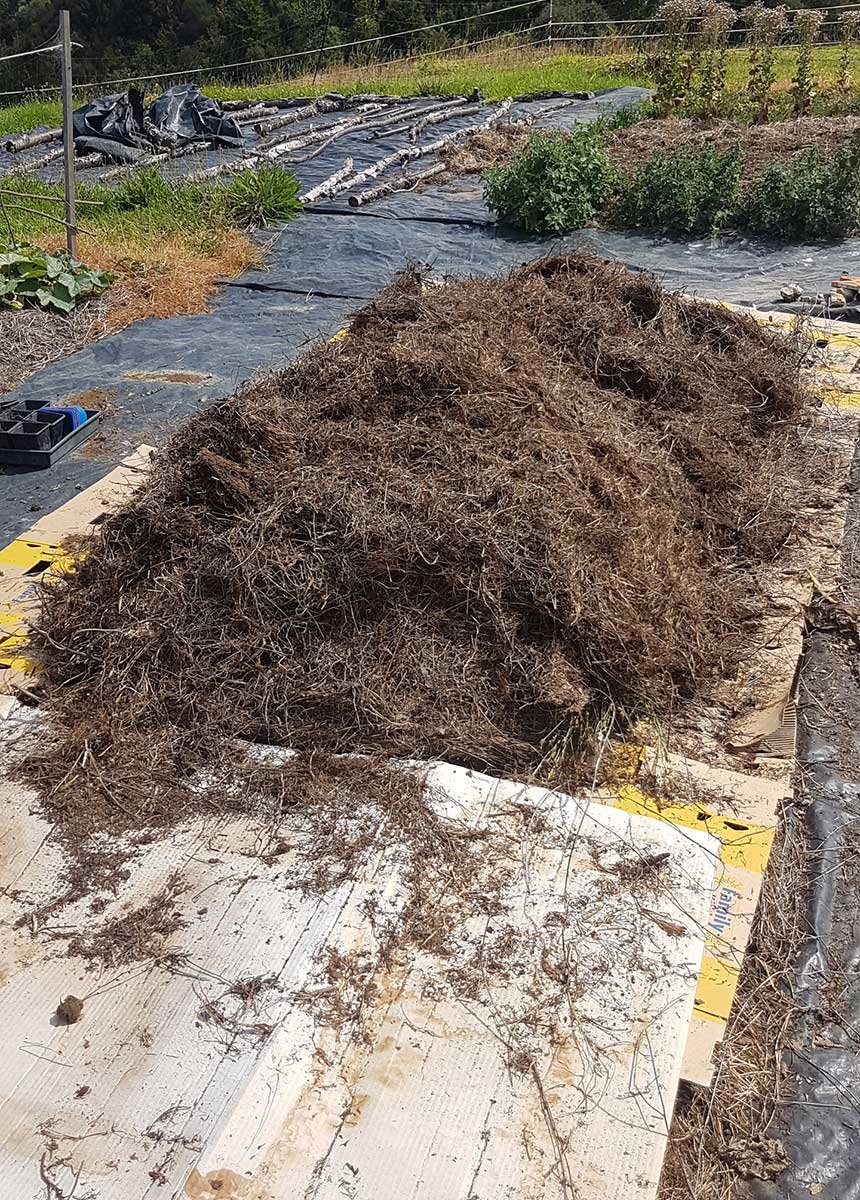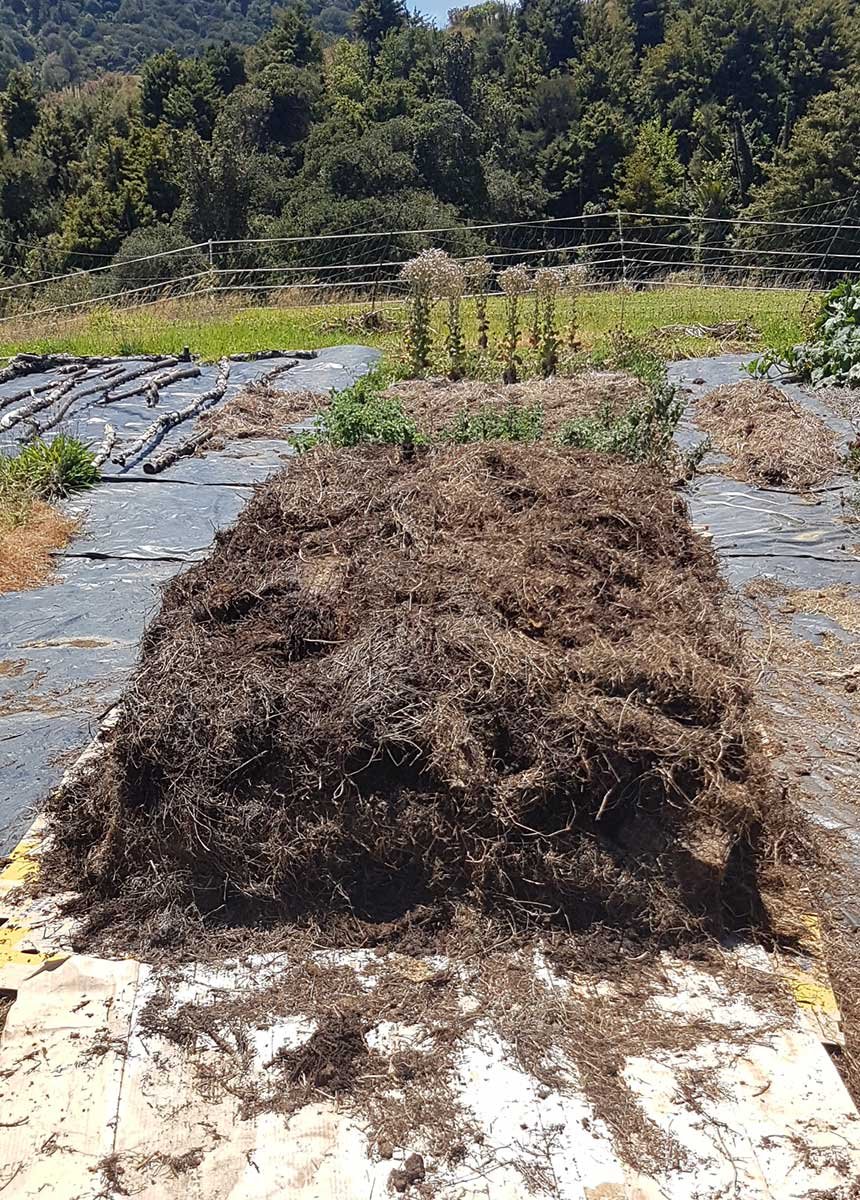I had a few problems going on all at once last week:
- there were garden beds that had finished and which needed tidying up and reusing.
- I had more than half a giant ball of mulch sitting in the chook yard, growing mushrooms.
- There were several dozen bags of horse manure collected from a neighbour lying around our driveway.
- I didn’t have enough compost and have been buying it in.
- And I still had more than a whole pallet of cardboard to use.
The solution to a whole bunch of these issues – I decided – was to create a giant compost pile on one of the vegetable beds.
The bed
First step: clear the bed. Last year, I’d planted this bed in radishes, onions, carrots, and collared greens as we went into lockdown.
The onions didn’t germinate at all, and we only got about half a dozen carrots. We discovered we don’t really like collared greens. The radishes grew well beyond what we could eat and I sold a few boxes of them, before feeding the rest to our chickens and the wormfarm.

I’d let two radishes go to seed, so they could self-sow around the place. This is actually my preferred way to garden: allow a plant or two to go to seed, so it just pops up wherever the hell it wants to. Eventually, I won’t need to sow most of my favourite plants – they’ll just grow when and where it suits them.
But anyway, two very dead radishes had sat in that bed for months. I’d managed to clear half the bed in spring and plant out four courgette plants. They did amazingly – until they got powdery mildew and carked it. So I had a bed that really needed clearing, but nothing really to put into it.
It’s a bed in the middle of the garden. It measures 1.8m x 4m, so it’s big enough to host a really huge compost pile. And the dead/dying plant matter could be added to it. Perfect!
Making waste useful
I cleared out the bed (squashing an unbelievable number of green vegetable bugs as I did).
Then I began with a layer of cardboard. We’re still working on mulching the orchard, but I have so, so, so many unused cardboard boxes. I didn’t bother to wet them, I just wanted something quick on the base to help prevent weeds invading.
Then I began layering my spoiled hay and horse manure. The spoiled hay is working as my carbon, and the horse manure is my nitrogen. Therefore I want way more hay (30x more, ideally) than horse manure in each layer. I was aiming to use the entire mulch ball and as much manure as I could in this compost pile.

Layer of cardboard, horse manure, and the organic matter just cleared from the garden bed.

Covered in a layer of spoiled hay.
It was sweaty work in the heatwave we were experiencing, but I wanted to get a pile that was over 1m tall, 1.5m wide, and 3m long. I was aiming for a hot compost.
Hot composting
When you get a hot compost right, you can end up with a perfect compost product really fast (some claim under 3 weeks if you get it perfect, but I’m aiming for under 3 months). It’s called ‘hot composting’ because the mixture gets so hot with biological activity that you can literally roast a chicken inside one.
A hot compost pile needs to be at least 1m x 1m x 1m. So it’s big. Generally, you create a hot compost pile in one go – rather than adding household scraps incrementally over time. The carbon:nitrogen ratio is important to aim for – it doesn’t have to be perfect, but you need heaps more carbon than nitrogen to make it work. As well as carbon and nitrogen, the pile also needs water and air.
In the first few days, temperatures get up really high in the center of the pile. So hot, you can’t stick your hand inside it. Then, as the biological activity dies down, it cools off. At that point, you need to turn it, which activates the biological reaction again. Do this a few times and you get a huge amount of compost really quickly.
I built the compost at the high end of the bed, with room at the low end to turn it onto when it was ready.

Layer of horse manure.

Repeat spoiled hay and horse manure again, and again, and again…
New toy
For Christmas, Richard bought us a big, big tipping wheelbarrow. It can attach to our quadbike and I imagine it will get a lot of use into the future. It’s inaugural use was to transport the mulch from the chook enclosure to the garden.

It easily holds four times what a normal wheelbarrow holds, and so I carted load after load into the garden (it was 6 loads in total), occasionally adding a few bags of horse manure in between (I used 15 of those in the end).
The compost pile got taller and the mulch ball got smaller. The bags of horse manure disappeared from our driveway.
Towards the bottom, the mulch ball looked mostly like compost anyway. It was at least 50% of the way to becoming rich organic matter. It became harder to scoop, but soon enough, the mulch ball disappeared entirely. Once the mulch ball was finished, and the pile was complete, I watered it with 60 litres of water, which will have to be enough to get started.
And now, we wait
I don’t have a compost thermometer, so I don’t know what the internal temperature got to. It’s definitely heating up in there, but I wouldn’t try cooking inside it.
It probably needs more water. My fingers are crossed for a bit of rain in the near future. A good dousing is exactly what I need to get the pile pumping.
My dimensions are probably off – going taller and not as wide might have been the smarter call. But I can always fix that when it’s time to turn it.
It will be 2-3 weeks before we turn it, and it may need turning a few times before it’s done. But once it’s finished, I’ll hopefully have enough compost to enrich a bed or two. It was hot and sweaty work, but I’m glad I took the day to put it together and reduce the amount of stuff hanging around.


